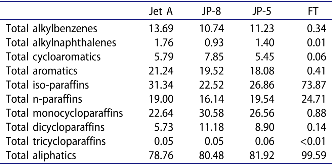Comparative electrophysiological evaluation of hippocampal function following repeated inhalation exposures to JP-8, Jet A, JP-5, and the synthetic Fischer Tropsch fuel
- Naval Medical Research Unit Dayton (NAMRU-D), Wright-Patterson Air Force Base, Dayton, OH (United States); Oak Ridge Inst. for Science and Education (ORISE), Oak Ridge, TN (United States)
- Naval Medical Research Unit Dayton (NAMRU-D), Wright-Patterson Air Force Base, Dayton, OH (United States)
- Naval Medical Research Unit Dayton (NAMRU-D), Wright-Patterson Air Force Base, Dayton, OH (United States); cCAMRIS International, Bethesda, MD (United States)
Exposure to fuels continues to be a concern in both military and general populations. The aim of this study was to examine effects of in vivo rat repeated exposures to different types of jet fuel utilizing microelectrode arrays for comparative electrophysiological (EP) measurements in hippocampal slices. Animals were exposed to increasing concentrations of four jet fuels, Jet Propellant (JP)-8, Jet A, JP-5, or synthetic Fischer Tropsch (FT) fuel via whole-body inhalation for 20 d (6 hr/d, 5 d/week for 28 d) and synaptic transmission as well as behavioral performance were assessed. Our behavioral studies indicated no significant changes in behavioral performance in animals exposed to JP-8, Jet A, or JP-5. A significant deviation in learning pattern during the Morris water maze task was observed in rats exposed to the highest concentration of FT (2000 mg/m3). There were also significant differences in the EP profile of hippocampal neurons from animals exposed to JP-8, Jet A, JP-5, or FT compared to control air. However, these differences were not consistent across fuels or dose dependent. As expected, patterns of EP alterations in brain slices from JP-8 and Jet A exposures were more similar compared to those from JP-5 and FT. Further longitudinal investigations are needed to determine if these EP effects are transient or persistent. Such studies may dictate if and how one may use EP measurements to indicate potential susceptibility to neurological impairments, particularly those that result from inhalation exposure to chemicals or mixtures.
- Research Organization:
- Oak Ridge Inst. for Science and Education (ORISE), Oak Ridge, TN (United States)
- Sponsoring Organization:
- USDOE
- Grant/Contract Number:
- WUN H1320
- OSTI ID:
- 1494675
- Journal Information:
- Journal of Toxicology and Environmental Health: Part A, Vol. 81, Issue 10; ISSN 1528-7394
- Country of Publication:
- United States
- Language:
- English
Web of Science
Toxicity and occupational exposure assessment for Fischer-Tropsch synthetic paraffinic kerosene
|
journal | July 2018 |
Similar Records
Acute toxicity evaluation of JP-8 jet fuel and JP-8 jet fuel containing additives. Final report, November 1995-February 1996
Activation of the canonical nuclear factor-κB pathway is involved in isoflurane-induced hippocampal interleukin-1β elevation and the resultant cognitive deficits in aged rats







